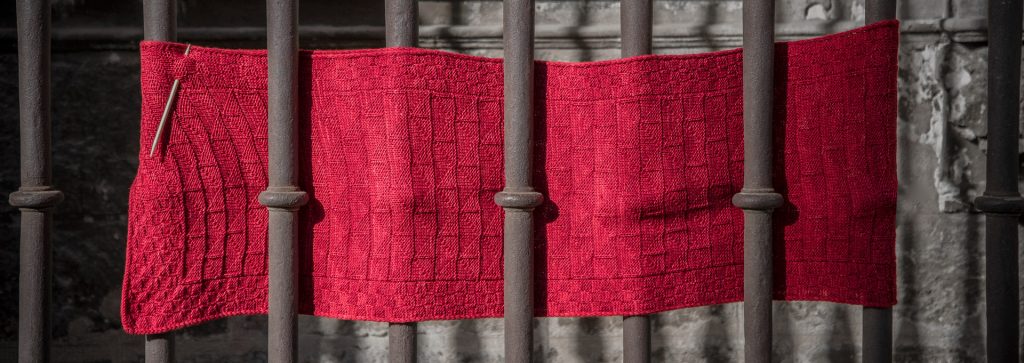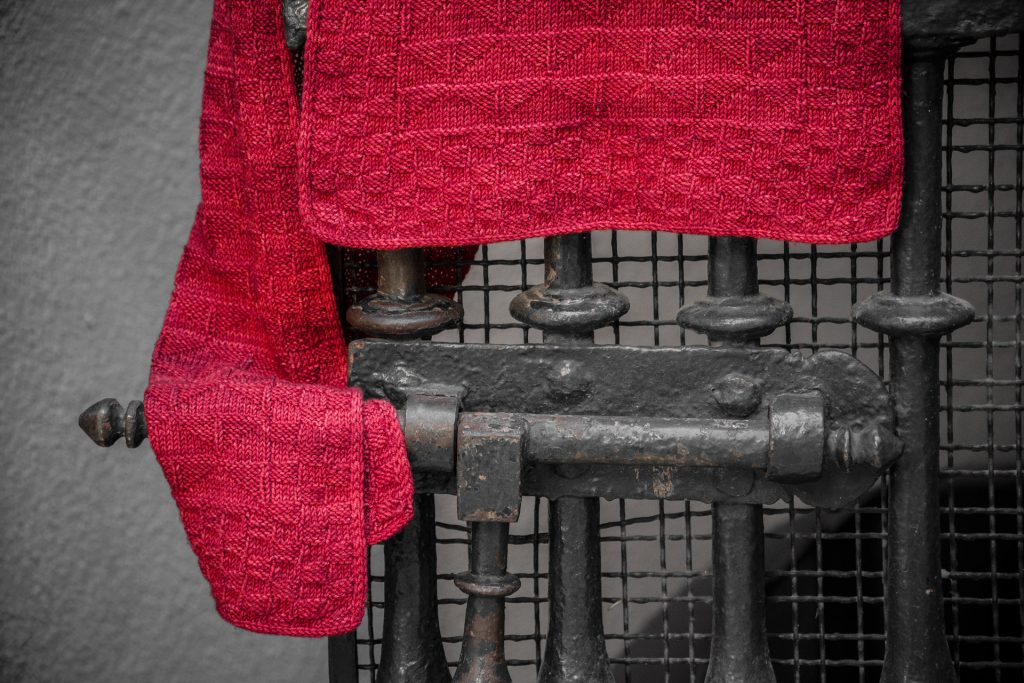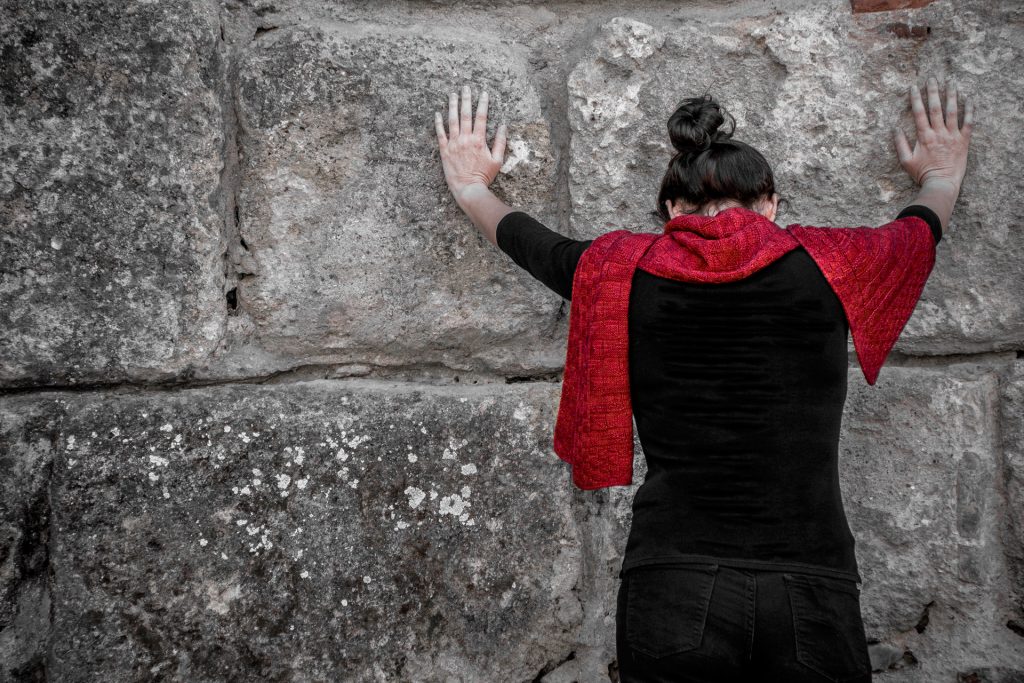June Stole Pattern
a free knitting pattern
by Beatriz P. Martín
In this blog post I am sharing the pattern to knit the June Stole (#junestole) with you all. My motivations to do this and the circumstances that have inspired me for this design can be found in my Mayday – The Handmaid’s Tale blog post, and if you came here after reading it, you already know them and I am only going to add some notes here about the design itself. But if you have reached this post directly and not through my older post Mayday – The Handmaid’s Tale blog post, I’d love you to read it because it’s a very personal motivation and I’d love to share it with anyone knitting this garment 🙂
When I first laid this design out, I wanted, as I explain in the post I’m referring to, a symbolic garment: a uniform. A symbolic language requires simple and well defined ideas in order to work out, that’s why I simplified the design to the max, my sensations after watching the TV series I am paying a tribute to: “The Imprisoned Femaleness“
I wanted a garment that was simple, yet suggestive. It was clear to me that I wanted to play with the texture created by combining knit and purl stitches and, for obvious reasons, the triangle is the geometric shape that best represents femaleness, so this shape had to make up the center part of the stole… The rest was easy, a grid of bars would make up the iron bars locking femininity up
Construction Notes
The stole is knit in two halves that are then grafted in the center to keep the symmetry of the central pattern when worn. As it is also edged by an I-Cord, the stitches have to be Cast On provisionally for both pieces, these stitches will be worked after the stole is finished and an I-Cord edge is worked by Binding Off in this technique. The I-Cord edge is knit at the same time the stole is worked. There are instructions for each separate piece at the beginning, as the Squares Pattern for the edge needs to begin with an inverted sequence so that the squares stay in the center where they will be joined. The beginning edge and side edges are worked following the 8 Row pattern (each piece individually) and the squares pattern is worked following the rows from the Chart.
Materials
- 800 m (875 y) fingering weight yarn, in red
- 4mm (US 6) circular needles, 60 or 80 cm (24″ or 32″) cable. It can also be knit with straight needles.
Yarn
- 3 skeins of malabrigo Sock, in color Ravelry Red
Gauge
Gauge is not important, the finished measurements will vary with your tension, but not greatly. If you are a very tight knitter you can go up a needle size, 4.5mm (US 7) to get a stole with more/better drape
Pattern
Left Piece
Provisionally Cast On 90 sts and work 2 repeats of the Squares Pattern (8 rows), simultaneously work an I-Cord edge, and then again work Row 1 to Row 7 of the Squares Pattern as follows:
Squares Pattern
Row 1 (RS): k3 ( k4, p4), repeat the instructions between the brackets to the last 3 sts, k3.
Row 2 (WS): sl3wyf, (p4, k4), repeat the instructions between the brackets to the last 3 sts, sl3wyf
Row 3: same as Row 1
Row 4: same as Row 2
Row 5: k3, (p4, k4), repeat the instructions between the brackets to the last 3 sts, k3
Row 6: sl3wyf, (k4, p4), repeat the instructions between the brackets to the last 3 sts,sl3wyf
Row 7: same as Row 5
Row 8: same as Row 6
Once the 7 rows of your third repeat are worked (ending with a WS row), work Next Row:
Next Row (WS): Work Row 8 of the Squares pattern on the first 15 sts, p2tog, k2tog, k to the last 15 sts, work Row 8 of the Squares Pattern on the last 15 sts.
After this last Row you will have 89 sts on your needles. 15 for each of the side edges and 59 for the middle sts.
From now on you will be working the Squares Pattern on the 15 sts for the edge, and according to the following Chart on the center 59 sts. Continue working Row 3 from the Squares Pattern and Row 2 (RS) from the Center Chart.
Center Chart

![]() K on RS rows and p on WS rows
K on RS rows and p on WS rows
P on RS rows and k on WS rows
Note on reading the Chart: odd numbered rows are WS rows and should be read from left to right. Even numbered rows are RS rows, and should be read from right to left.
Continue in pattern, working a total of 16 repeats of the Center Chart, while simultaneously working the 8 Rows from the Squares Pattern on the first and last 15 sts, ending on a Row 4 from the Squares Pattern. Leave the sts on hold on waste yarn or a needle cable and start the Right Piece of your Stole.
Right Piece
Provisionally Cast On 90 sts and work 2 repeats of the Squares Pattern (8 rows), simultaneously work an I-Cord edge, and then again work Row 1 to Row 7 of the Squares Pattern as follows:
Squares Pattern
Row 1 (RS): k3 ( p4, k4), repeat the instructions between the brackets to the last 3 sts, k3.
Row 2 (WS): sl3wyf, (k4, p4) repeat the instructions between the brackets to the last 3 sts, sl3wyf
Row 3: same as Row 1
Row 4: same as Row 2
Row 5: k3, (k4, p4) repeat the instructions between the brackets to the last 3 sts, k3
Row 6: sl3wyf, (p4, k4), repeat the instructions between the brackets to the last 3 sts,sl3wyf
Row 7: same as Row 5
Row 8: same as Row 6
Once the 7 rows of your third repeat are worked (ending with a WS row), work Next Row:
Next Row (WS): Work Row 8 of the Squares pattern on the first 15 sts, p2tog, k2tog, k to the last 15 sts, work Row 8 of the Squares Pattern on the last 15 sts.
After this last Row you will have 89 sts on your needles. 15 for each of the side edges and 59 for the middle sts.
From now on you will be working the same way you worked the Left Piece and will end it the same way, after having made 16 repeats of the Center Chart, and endi Row 4 from the Squares Pattern on the edage sts.
Once both pieces are finished,you will graft them together, also known as joining with the Kitchener Stitch (an invisible join). Place one piece on top of the other with both WS facing each other on the inside and both RS facing out. Now graft them together.
The 3 sts from the I-Cord edge will be grafted as knit sts, then the next 12 st will be: 4 purl sts, 4 knit sts and 4 purl sts, the next 59 sts will be grafted as knit sts, and again the next 12 sts will be: 4 purled sts, 4 knit sts and 4 purled sts, then again the 3 sts from the I-Cord edging will be grafted as knit sts.
For a video tutorial (and written instructions in the description box), on how to graft both Knit and Purl sts, please see this video on Kitchener Stitch for Both Knit and Purl Stitches. She demonstrates how to graft both knit and purl stitches, but don’t follow her pattern blindly, learn the technique and apply it to your knit & purl sts accordingly.
Once both pieces are grafted, go back to the edge stitches on both pieces, work these sts unraveling the waste yarn very carefully as to not loose the sts, and on the RS work the edge I-Cord as follows:
With the RS facing you, join in new working yarn and using the Knitted Cast On method, CO 3 new sts on your LN and begin working an I-Cord Bind Off as follows: * k2, k2tog-tbl,you will now have 3 sts on the RN, slip them back to the RN and repeat from *, This way you will be casting 1 st off each time you repeat this sequence. Work this way until you have 3 sts left, slip them back to your LN, k2tog-tbl, slip the st back to your LN and again, k2tog-tbl, you will have 1 remaining st on your RN. Break yarn and pull though st.
Work the other piece exactly the same way
Finishing
Weave ends in and wash the top with a mild soap and a bit of fabric softener: Fill a sink or bucket with lukewarm water and add a bit of mild soap or wool wash, soak the garment completely, and gently squeeze, removing all air, making sure it is entirely wet. Let it soak for approx 30 minutes. Drain the sink or bucket and refill it with cool water. Keep rinsing the item until the water is clear and without suds. You can add a little fabric softener. Never place the item directly under the tap or water stream. Once rinsed, squeeze the water out with your hands and wrap with a clean, dry towel and squeeze again (your own body weight can help remove excess water). The garment must end up a bit wet, but not soaked. Extend the garment over a flat surface and flatten out any wrinkle or crease, stretch to the specified size. Let dry flat, away from direct sunlight.
Abbreviations & Stitch Guide
RS Right side of work
LR Wrong Side of work
K Knit
P Purl
LN Left Needle
RN Right Needle
P2tog (Purl Two Together): Insert your working needle into the first two stitches on your main needle, purlwise. Wrap the working yarn over the working needle, going over the top and around the bottom. Push the working yarn through both stitches on the main needle. Pull both stitches off the main needle. (One stitch decreased, left leaning slant)
Sl3wyf slip 3 sts as if to purl with your working yarn in front of work
K2tog-tbl Knit 2 Together Through Back Loop (Left-Leaning Decrease). Step 1: Insert your working needle into the back leg of the first stitch on your main needle, going purlwise, and through the second stitch. They should cross each other forming an “X” with the working needle on bottom. Step 2: Wrap the working yarn over the working needle on bottom. Wrap by going under and around. Step 3: Pull the working yarn through with the working needle through both stitches on the main needle. Pull towards you. Step 4: Slip both stitches off the main needle.
Knitted Cast On knit the first stitch on your left needle and, without sliding your first st off the left needle, bring your newly knit st back to the left needle, you’ll have a new st on your left needle.
Kitchener Stitch (Grafting)
Grafting or Kitchener Stitch is used to sew or join sts without binding them off as if they were knit, it’s an invisible join because the join looks knit. We must use the same yarn used for the garment, you will need a tail that is 3-4 times the length of your finished edge.
Grafting Knit Stitches
- Step 1: With your waste yarn threaded through a tapestry needle, insert the needle into the first stitch on your main needle purlwise and pull all the way through. Drop the stitch from the main needle. [Note: If the first stitch is a purl stitch, insert the needle through the first two stitches and drop them both.]
- Step 2: Insert your tapestry needle in the next purl stitch on your main needle knitwise and pull tight. (It should be the first stitch on your main needle). Leave this stitch on the main needle.
- Step 3: Insert your tapestry needle into the dropped knit stitch, purlwise, and through the next knit stitch on your main needle (it should be the second stitch on your main needle) and pull tight.
- Step 4: Insert your tapestry needle into the purl stitch on your main needle again, this time going purlwise. Pull tight.
- Step 5: Drop both the purl and knit stitch from your main needle.
Repeat steps 2 – 5 until you have bound off all your stitches.
Grafting Purl Stitches
Work exactly as you would for a knit st, but the step sequence changes as follows:
- Setting Up for Purl Stitches: Front Needle: Insert tapestry needle into stitch knitwise, pull stitch off needle, go into next stitch purlwise. Back Needle: Insert into stitch knitwise, pull stitch off needle, go into next stitch purlwise.
- Grafting Purl Stitches: Front Needle: Insert tapestry needle into stitch knitwise, pull stitch off needle, go into next stitch purlwise. Back Needle: Insert into stitch knitwise, pull stitch off needle, go into next stitch purlwise
Three Needle Bind Off
It is a great way to both bind off and seam at the same time – very often it is used for the shoulder seams of sweaters.
Note that a 3-Needle Bind Off and the Kitchener Stitch are somewhat interchangeable. The advantage of a 3-Needle Bind Off is that it’s easier to do and that, because it creates an actual seam, it offers some structural integrity. The Kitchener Stitch is a bit trickier to work, but it creates a smooth and seamless finish. Same but different!
- To end up with the seam on the wrong side of your knitting, arrange the two pieces with their wrong sides facing out.
- Hold the needles parallel and slip a third (working) needle into the first stitch on each of the two needles.
- Wrap yarn around working needle as if to knit, and knit the two stitches together. Allow the first stitch from each of the parallel needles to fall from the needles.
- Knit together the new first stitch on both parallel needles in the same way as above.
- There will be two stitches on the working needle. Using one of the two parallel needles, pass the first stitch on the working needle over the second stitch and off the needle, as you normally would when binding off.
- Repeat from * until only one stitch remains on the working needle. Break yarn and pull the tail through the last stitch to fasten off
See also common abbreviations in our patterns
[printfriendly]










